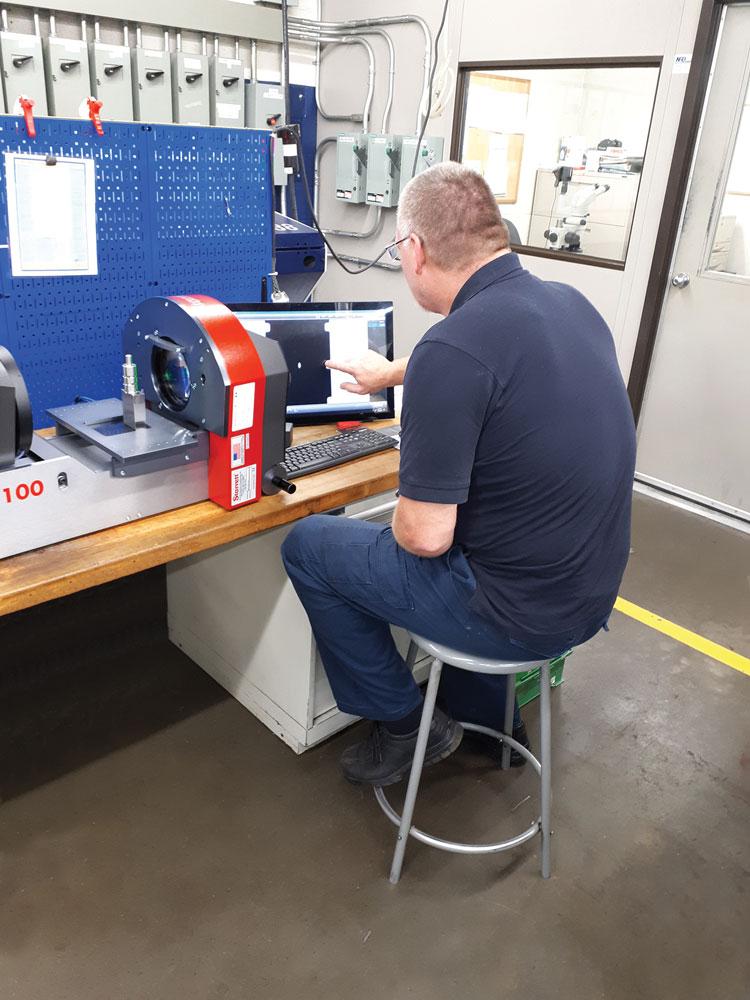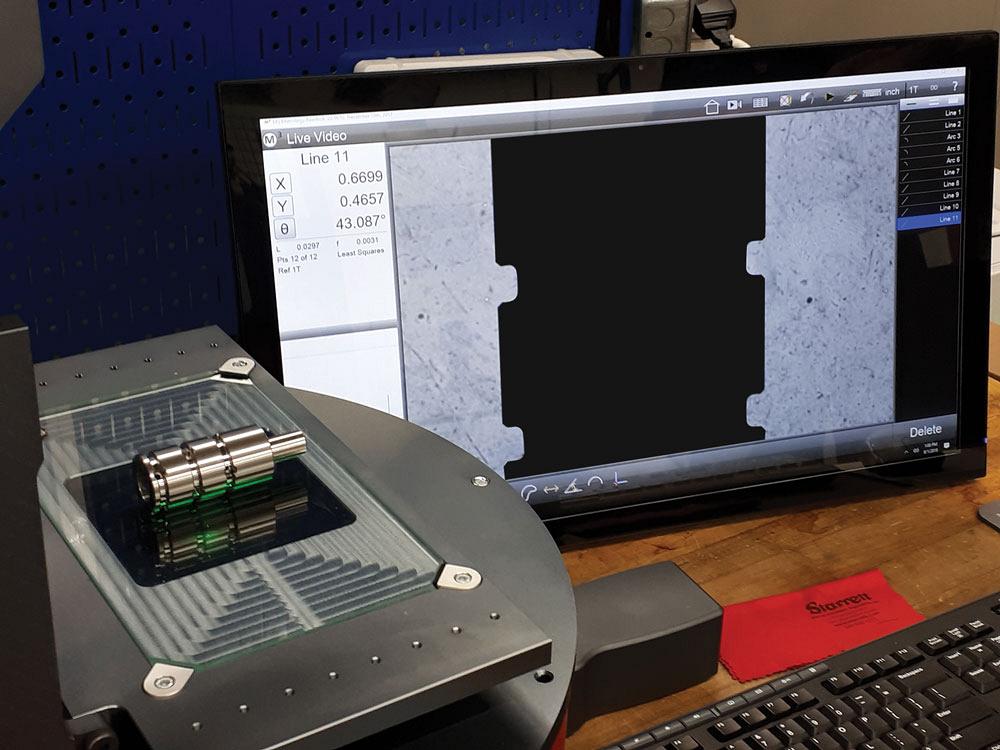Associate Editor
- FMA
- The Fabricator
- FABTECH
- Canadian Metalworking
B.C. Instruments’ new vision system ensures part quality
The Starrett HVR-100 vision system allows the quality team to inspect multiple features on a part in seconds rather than minutes, which was the previous benchmark.
- By Lindsay Luminoso
- September 20, 2018
- Article
- Measurement

Ron Davidson, team leader at B.C. Instruments, inspects a part on the company’s new Starrett HVR-100 Flip vision system that is being used here in a horizontal orientation.
Founded in 1971, privately owned B.C. Instruments (BCI) continuously strives for improvement while expanding its reach and capabilities in the precision machining market. Headquartered in Schomberg, Ont., the company offers five business divisions—injection molding, aerospace, medical, power generation & nuclear, and electronic—within six different buildings across the province.
Each division runs independently, but collectively the company has 150 employees with more than 100 people on the shop floor, operating both a day and night shift across all locations.
Throughout the six buildings, the company has approximately 10 people dedicated full time to quality assurance (QA), with an additional 30 qualified inspectors on the shop floor. The company’s QA manager Mike Spence ensures quality standards are maintained in all areas of the business. In the past year, the company has focused its attention on making its quality process even more efficient in its injection molding unit.
“Our challenge in the injection molding [unit] is it’s an extremely competitive and fast-moving industry,” said Roger Conzelmann, president of B.C. Instruments. “We have short lead times [in this segment] versus [other divisions] like power generation, which has longer lead times. To compete, we needed to look for improvements in our inspection process to decrease any downtime on the production equipment.”
THE CHALLENGE
Over the past few years, Conzelmann noticed that more inspection was happening on the undertook work for the refurbishment of all four reactors at the Darlington Nuclear Power Plant, Clarington, Ont., one of Canada’s largest clean infrastructure projects, which requires 100 per cent inspection of all components. BCI had multiple coordinate measuring machines (CMMs), next-gen height stands, comparators, micrometers, calipers, and other metrology devices but needed something to deal with the stringent standards and short lead times in its injection molding segment.
“Some of the prior inspection technologies were somewhat cumbersome, and we found that they hampered production flow,” explained Conzelmann. For example, when it came to nuclear power components, the team would machine each part and then each component would need to be taken off the production line and taken to the CMM for measurement, which tended to be a slow process depending on the part complexity.
It wasn’t until CMTS 2017 in Toronto that Sean Smith, the department’s plant manager and Brent Cordy, quality insurance inspector, began to investigate new inspection technology. Over a six-month period, the company’s quality team evaluated several different options before settling on the HVR-100 Flip Digital Video System from The L.S. Starrett Co., based in Athol, Mass.
“We’ve had the vision system now for about two months,” said Cordy, adding that the device will primarily be used to inspect injection molding components.
“The machine is so intuitive,” Cordy added. “It is cumbersome and inefficient for our operators to load and unload parts from the production machines in order to measure on a standard optical comparator. That’s why we needed something like this vision system.”
NOZZLE INSPECTION
According to Cordy, the Starrett HVR-100 vision system allows the quality team to inspect multiple features on the part in a matter of seconds rather than a matter of minutes, which was the previous benchmark. The speed of the system is a huge advantage to the entire manufacturing process.

The vision system, shown here in vertical orientation, can run an inspection process report and import a CAD model, increasing uptime and decreasing the amount of programming.
Inspection runs primarily on a family of parts—such as a nozzle used for injection molding. The nozzles end up servicing multiple industries including the food packaging and medical sectors, functioning as the last component where the plastic flows before entering the mold. The nozzle is under extreme pressure and high temperatures. The part is made in several different materials, including titanium and hardened steel.
Conzelmann notes that these parts require extremely tight tolerances. The part features a critical thread on one end, a variety of profiles on the outside diameter, and different milling features, all of which need to be inspected.
“There are thousands of variations of this nozzle component, which the customer changes almost daily,” said Conzelmann. “We have very repetitive, similar-looking parts. They are a couple inches long and under 1 in. in diameter. The features are somewhat similar, with a combination of different lengths. But, like I said, the components are constantly evolving, designed within the same family. We have a very short timeframe from getting a new design from a customer to manufacturing and shipping the parts. That’s why we needed an inspection device that offered speed and flexibility.”
VISION SYSTEM
The Starrett HVR-100 Flip system can be used in a horizontal or vertical configuration. BCI currently is working with the device in the horizontal option. However, the team plans to use the vertical configuration in the near future.
“We are examining our fixturing options and standardizing the process for vertical orientation,” explained Cordy. “We’d like to use the device vertically because it offers a smaller footprint, which is conducive to being on the shop floor.”
According to Cordy, this device has an excellent field-of-view, allowing quality inspectors to see the entire part at once. It also allows the company to measure threads, which he stresses is very important for these nozzle components.
But it is really the ease of use that Cordy finds most helpful: “You can create a program in 30 minutes, and then it’s functional for the operators to plug and play to QC the part.”
Conzelmann added that the system’s part recognition feature is ideal for inspecting the large family of nozzle components. It’s exactly what the company needed for components with extremely tight tolerances, and it reduces the time spent on verification.
“We can have parts coming off multiple machines, and the system can identify different part profiles and dimensions automatically. It will run an inspection process report and import a CAD model, which increases uptime and decreases the amount of programming,” he explained.
PRODUCTIVITY GAINS
BCI has undergone several changes over the last few months to deal with increased market demands. It recently added a new turning centre and is looking to add a milling machine and second turning centre as part of its overall expansion plan. With new machining equipment, run time was drastically reduced, which furthered the need for a new method of inspection. The vision system could measure parts quickly, which in turn, sped up the entire manufacturing process. Typically, the quality department would check one in every 10 features of a part. Now, it can check all features of a part.

The Starrett HVR-100 Flip system can be used in a horizontal or vertical configuration. BCI team plans to use the vertical configuration because it offers a smaller footprint and is better suited for the shop floor.
“We now have multiple people checking multiple features per part,” said Conzelmann. “From an operator’s perspective, it has made things a lot easier and faster. There is little to no need for manual recording with this device. It also has improved overall accuracy and traceability.”
Additionally, BCI can monitor tool wear with the system. Conzelmann notes that in the past inspectors would have previously caught tool wear, but it might not have been noticed until after 20 to 30 parts were manufactured.
With the tight tolerances BCI’s customers demand, all components can be measured up to six or seven times depending on the number of assemblies and machining processes needed, and adjustments can be made at the first sign that the part if out of spec.
“Accumulated savings is essential for us, and this system certainly saves time,” said Conzelmann. “We ship these parts globally and need to keep the price down and meet fast shipping requirements. Our customers are constantly pushing our boundaries, with delivery speed playing an important role. Without the technology to verify the features instantly, it would be very challenging.”
The goal is to meet ever-growing customer demands through adding support services for the manufacturing process. And incorporating easy-to-use vision inspection is a trend B.C. Instruments hopes to build on.
Associate Editor Lindsay Luminoso can be reached at lluminoso@canadianmetalworking.com.
B.C. Instruments, www.bc-instruments.comL.S. Starrett Company, www.starrett.com
About the Author

Lindsay Luminoso
1154 Warden Avenue
Toronto, M1R 0A1 Canada
Lindsay Luminoso, associate editor, contributes to both Canadian Metalworking and Canadian Fabricating & Welding. She worked as an associate editor/web editor, at Canadian Metalworking from 2014-2016 and was most recently an associate editor at Design Engineering.
Luminoso has a bachelor of arts from Carleton University, a bachelor of education from Ottawa University, and a graduate certificate in book, magazine, and digital publishing from Centennial College.
Related Companies
subscribe now


Keep up to date with the latest news, events, and technology for all things metal from our pair of monthly magazines written specifically for Canadian manufacturers!
Start Your Free Subscription- Industry Events
MME Winnipeg
- April 30, 2024
- Winnipeg, ON Canada
CTMA Economic Uncertainty: Helping You Navigate Windsor Seminar
- April 30, 2024
- Windsor, ON Canada
CTMA Economic Uncertainty: Helping You Navigate Kitchener Seminar
- May 2, 2024
- Kitchener, ON Canada
Automate 2024
- May 6 - 9, 2024
- Chicago, IL
ANCA Open House
- May 7 - 8, 2024
- Wixom, MI




















